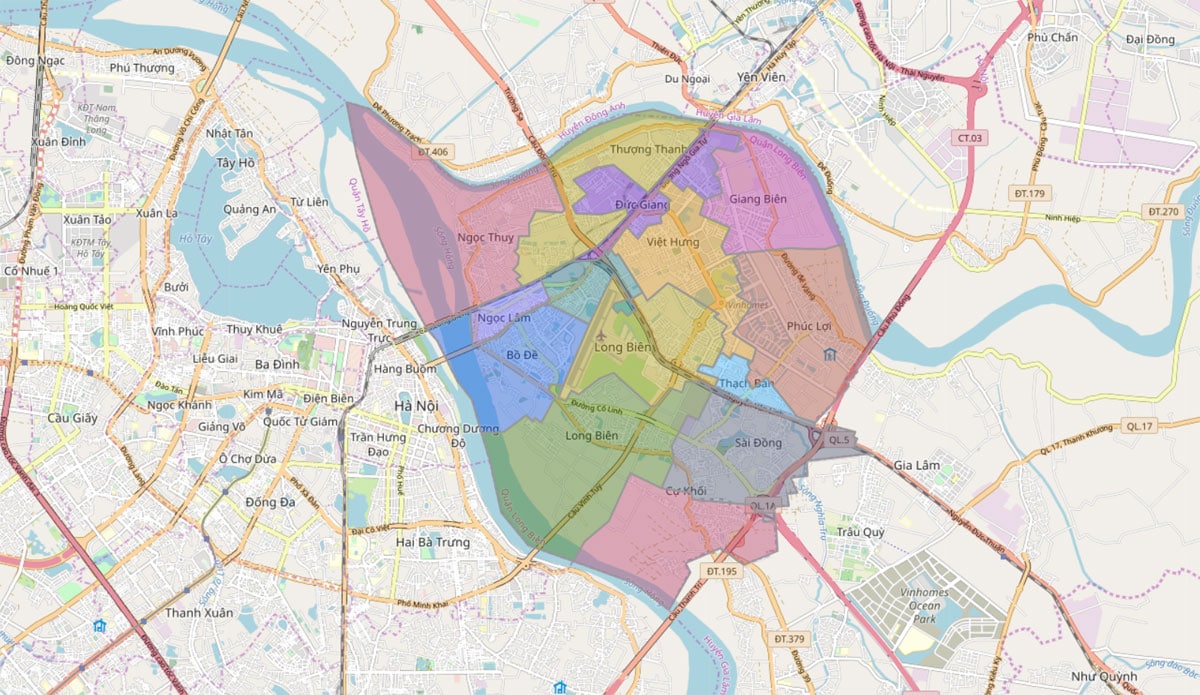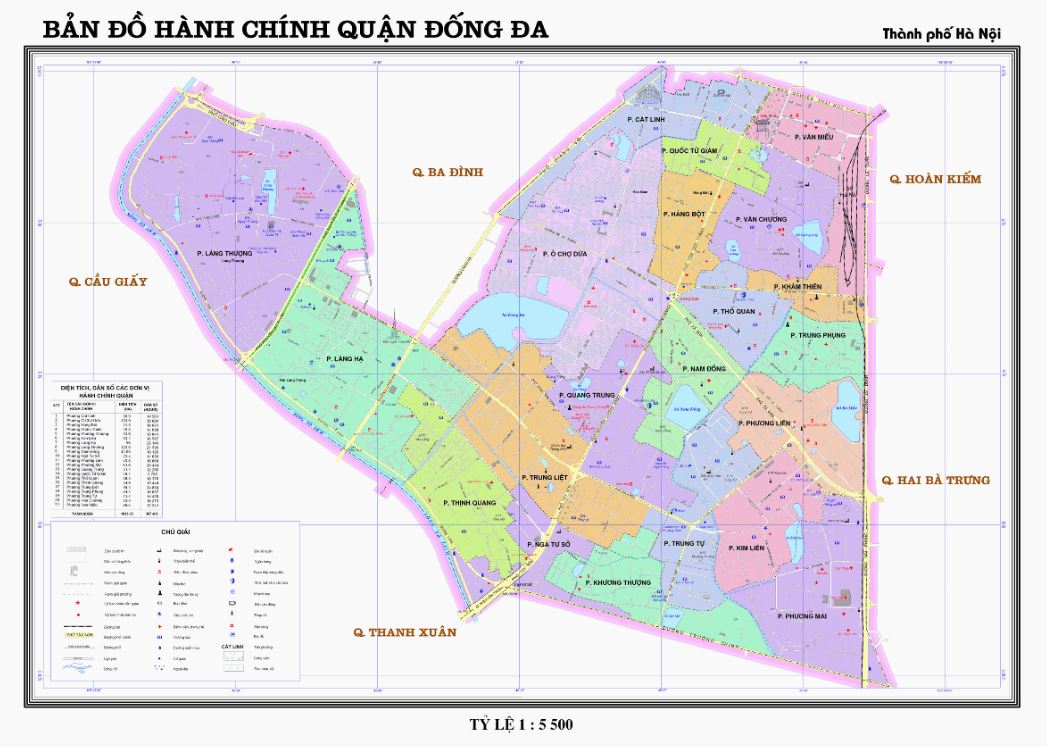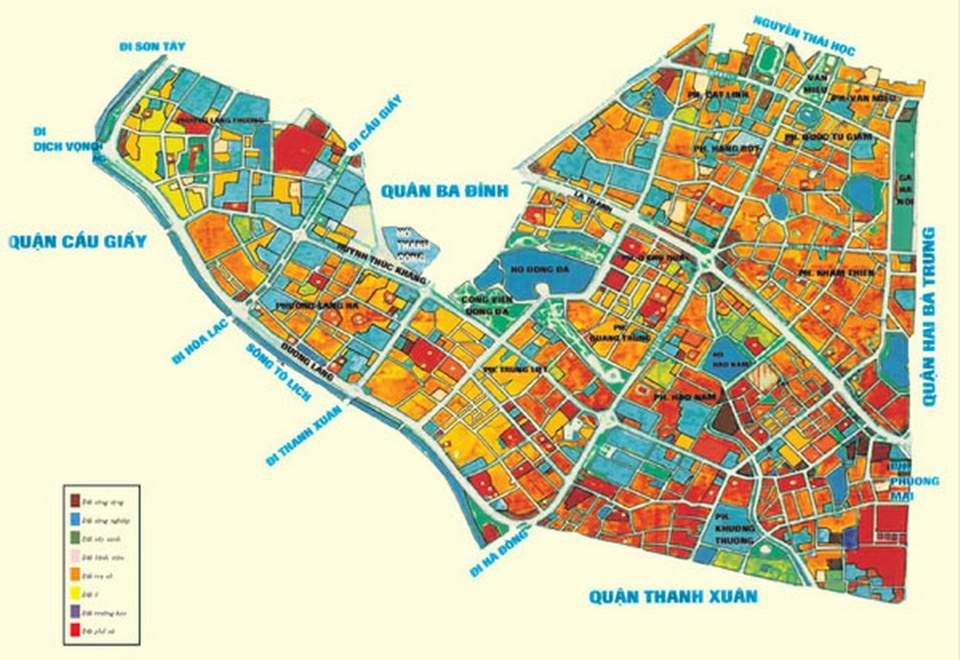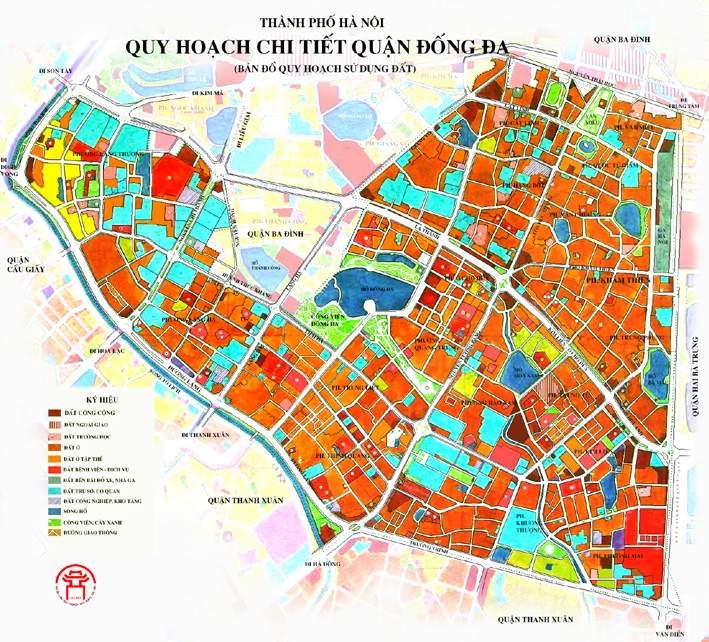You are looking for a large map of Dong Da District or an administrative map of wards in Dong Da, to look up information on housing planning, geographical boundaries in the area.
We truongptdtntthptdienbiendong.edu.vn synthesize and share the enlarged map of Dong Da District in 2023. In addition, we also provide and share information about the formation and development of Dong Da District.”
Overview of Dong Da District
Dong Da district is located in the southwest of Hanoi capital, with an area of 9.95 km2, divided into 21 administrative units, adjacent to 5 districts as follows: Hoan Kiem, Ba Dinh, Cau Giay, Thanh Xuan, Hai Mrs. Trung.
Dong Da is a district with many large university systems such as University of Transport, University of Foreign Trade, Hanoi University of Water Resources, Hanoi Medical University, Hanoi Law University…
Dong Da district is located in the center of Hanoi city, geographically located:
- To the north, it borders Ba Dinh district
- To the northeast, it borders Hoan Kiem district, the boundary is Le Duan street
- The East borders Hai Ba Trung district, the boundary is Le Duan street and Giai Phong street
- To the south, it borders Thanh Xuan district, the boundary is Truong Chinh street and Lang street
- To the west, it borders Cau Giay district, the border is To Lich river

The topography of Dong Da district is relatively flat. There are some large lakes such as Ba Mau, Kim Lien, Xa Dan, Dong Da, and Van Chuong. Before, there were many ponds and lagoons, but with the process of urbanization, they were filled. The district has two small rivers flowing through, namely To Lich river and Lu river. In the east, there are a few small mounds, including Dong Da mound.
Some cultural and historical relics in Dong Da district are Van Mieu-Quoc Tu Giam, Dan Xa Tac relic, Dai La citadel relic, Boc pagoda, Dong Da mound and the statue of King Quang Trung, pagoda. Lang, Bich Cau Temple, Hanoi Railway Station..
In addition, in the district, there is Dong Da mound, which is considered a mass grave of soldiers of the Qing Dynasty in China. The district is named after the victory at the battle of Dong Da of the Tay Son insurgents in the spring of the year of the Rooster (1789).
Administrative map of Dong Da District big format in 2023




Basic information about Dong Da District
Archaeological remains show that the land of Dong Da district was explored by the ancient Vietnamese very early. In 1978, when digging the To Lich River at the border of 2 villages Ha Yen Quyet and Thuong village (Tu Liem district), a coffin made of both hollowed-out wooden trees and burial accessories was found, dating back to the early Cong. original. Together with a sharpened stone ax in Quan Ngua, a bronze ax with a shoulder in Cong Vi, a bronze drum of type I in Ngoc Ha (Ba Dinh district), this document contributes to affirming the ancient nature of the inner city.
Dong Da district is part of the land of Thang Long Citadel, the land in the inner city over the historical periods has changed its geography and name many times. During the Han Dynasty, the land was Long Bien district in Giao Chi district; Song dynasty in Tong Binh district; Until the Sui dynasty set this district as the ruler of Annam, Tong Binh became the political center of Vietnam at that time.
Then the Han colonialists built here ramparts to prevent people’s uprisings, the biggest rampage in 864 called Dai La Thanh. Traces of that section may be the current La Thanh road. Also from here, the names La Thanh or Dai La have replaced the old name Tong Binh. Therefore, in 1010, in Ly Thai To’s “Relocation of the Capital”, it was mentioned that the capital was moved from Hoa Lu (Ninh Binh) to Dai La and then Dai La changed its name to Thang Long.
Thang Long under the Ly dynasty consisted of two areas “Thang Long citadel” ie the place where the king lived and set up the court and the residential area was the living place of nobles, farmers, workers and merchants called “Thang Long suburban”. Dong Da district is now located in this area. Both areas established an administrative unit called Ung Thien, in 1014 changed to Nanjing government.
In the Tran dynasty, in 1230, it was divided into 61 wards (there are no documents listing the names of 61 wards and it is not known which wards Dong Da district includes). During the Ho Dynasty, Thang Long was called Dong Do, then the Ming Dynasty changed it to Dong Quan. After defeating the invading Ming army, Le Thai To (Le Loi) changed it to Dong Kinh.
In 1466, Le Thanh Tong changed it to Trung Do. In 1469, it was changed to Phung Thien Palace. From here, the new history books specifically record the scope of the capital as including 2 districts of Vinh Xuong and Quang Duc. Each district is divided into 18 wards. According to Nguyen Vinh Phuc and Tran Huy Ba, among those 36 wards, Dong Da district now includes the land of wards: Vinh Xuong (Nguyen Khuyen street area), Bich Cau (Cat Linh – Van Mieu area), Thinh Quang (Thinh Quang – Ton Duc Thang), Xa Dan (Xa Dan – Kham Thien area), Dong Tac (Kham Thien – Trung Tu market alley area), Kim Hoa (Kim Lien – Trung Tu area). In the Tay Son Dynasty, Thang Long changed its name to Bac Thanh because the capital was moved to Phu Xuan (Hue).
In the Nguyen Dynasty, in the 4th year of Gia Long (1805), the Governor of Bac Thanh was set up, the name of Vinh Xuong district was changed to Tho Xuong, Quang Duc district to Vinh Thuan district, Phung Thien’s government became Hoai Duc’s government. In the 12th year of Minh Mang (1831), the king carried out the biggest administrative reform since the birth of Vietnam’s feudal system. King Minh Mang abolished the North citadel (including 11 towns and 1 affiliated government) in the North and established the province of Hanoi. The land of Dong Da district is still located on the land of 2 districts of Tho Xuong and Vinh Thuan. According to Dai Nam Nhat Thong Chi book, volume III, at the end of the 19th century, Tho Xuong district had 8 cantons, 115 villages and farms. According to the book “Vietnamese village names”, at the beginning of the 19th century, Dong Da district was located in the territory of the following districts: Tho Xuong, Vinh Thuan.
Since capturing Hanoi in 1883, especially since 1888, when taking Hanoi as a concession, the French colonialists had demolished many parts of the old Hanoi and planned to build a new urban area according to the plan. Western style.
On July 19, 1888, the French President signed a decree establishing the city of Hanoi before the recognition of the Hue court. On October 1, 1888, the Dong Khanh court signed a decree cutting Hanoi to the French colonialists as a concession. On October 3, Governor-General Richaud officially turned Hanoi into a city under the concession regime.
Hanoi at this time only consisted of inner-city neighborhoods divided into 63 wards with an area of 3 km2 with a population of about 270,000 people. The boundary of Hanoi at that time was started from West Lake, went north-south along Buoi street to Cau Giay, then changed east-southeast direction along La Thanh dike and then went straight through Kham Thien street, to Thien Lake area. Quang turned south-southeast to Luong Yen village (now Thanh Luong ward, Hai Ba Trung district).
In 1889, Hanoi established the outskirts of Hanoi, including a number of communes of Vinh Thuan, Tho Xuong, Tu Liem, and Thanh Tri districts. In 1904, the inner city of Hanoi was divided into 8 districts. In 1915, the suburbs of Hanoi changed to Hoan Long district (under Ha Dong province).
In 1942, France merged a part of Thanh Tri district of Ha Dong province into Hanoi, establishing “Hanoi Special Agent” including Hoan Long district and 22 communes under Hoai Duc government, divided into 8 cantons, 60 communes. Dong Da corresponds to the 3rd household (3C quartier) of 8 households in inner Hanoi.
After the August Revolution, Hanoi returned to its role as the capital. At this time, Hanoi capital consisted of 5 inner city areas and 120 suburban communes. On May 14, 1946, the Minister of Home Affairs approved the division of Hanoi city into 17 zones, each with its own name: Truc Bach area, Dong Xuan area, Thang Long area, Dong Thanh area, Dong Kinh Nghia area. Thuc area, Hoan Kiem area, Temple of Literature, Quan Su area, University area, Bay Mau area, Cho Hom area, Lo Duc area, Hong Ha area, Long Bien area, Dong Nhan area, Van Thai area and Bach Mai area.
On May 26, 1946, the Minister of Home Affairs approved the division of Hanoi suburb into 5 zones, each with its own name: Lang Bac area, Dai La area, Dong Da area, De Tham area, and Me Linh area. . A large part of the wards of Dong Da district belongs to Dong Da area.
In November 1946, implementing the policy of the Central Committee, War Zone XI (ie Hanoi) was established. To direct the arrangement of resistance forces, the inner city of Hanoi was divided into three inter-zones. Dong Da area is now located in Inter-zone 3 of the inner city.
From the end of 1947, the area of Inter-zone 3 – Dong Da was changed to District 5. Dong Da land includes 5 districts and a part of Thanh Tri district. In May 1948, Hanoi merged with Ha Dong province to form Mesopotamia. The suburban area of Hanoi is divided into two districts, Tran Tay and Tran Nam, with road 6 as the boundary.
On October 1, 1948, the Party Central Committee issued a directive to separate Hanoi from Mesopotamia, dividing it into two former provinces, Hanoi and Ha Dong. In February 1949, Hanoi redistributed administrative units after resistance bases were widely established in the inner city. Tran Tay and Tran Nam districts are divided into 2 districts 4 and 6. In the inner city, it is divided into 2 Interzones 1 and 2.
On June 13, 1949, Resolution No. 142-NQ/KC-Hanoi of the Hanoi Administrative Resistance Committee divided the inner city of Hanoi into two districts, named District 1, District 2 and divided the suburbs of Hanoi. Noi made 3 districts, named District 4, District 5, District 6. Dong Da now mainly belongs to the land of District 2 and District 5.
After the capital was liberated, the City Administrative Committee divided Hanoi into 4 inner city districts including 36 zones, 4 suburban districts including 46 communes. Dong Da was then located on the land of District 3 (inner city) and 3 suburban districts of Kham Thien (District 4), Tu Liem (District 6) and Thanh Tri (District 7).
In November 1957, after the election of the City People’s Council, term I, Hanoi was divided into 8 districts, Dong Da included the land of District 1 (Hang Co station area), District 3 (Van Mieu area), and District 4. O Cho Dua area), District 6 (Hao Nam, Thai Thinh) and District 7 (Phuong Lien commune).
In March 1958, the 4 inner city districts were replaced by 12 quarters, including the Van Mieu, Bach Mai, Bay Mau and O Cho Dua areas in Dong Da district. In 1959, 12 inner city quarters were divided into 8 quarters, of which Dong Da included the land of Dong Da, Bach Mai, and Hang Co areas.
On April 20, 1961, the Second National Assembly of the 2nd session approved the expansion of Hanoi City. On May 31, 1961, the Government issued Decision 78/CP dividing Hanoi into 4 neighborhoods and 4 districts. Dong Da was allowed to add a number of villages and communes of Thanh Tri district (such as Kim Lien, Phuong Liet) with an area. 11.75km2, becoming the largest neighborhood of the inner city, population 92,100.
On December 21, 1974, the City Council decided to establish sub-zones. Dong Da includes 48 sub-zones, including Yen Lang sub-zone from Tu Liem district.
In December 1978, the City Council decided to rearrange the sub-zones. Dong Da had 28 sub-zones, by 1980 the number of sub-zones was only 24. After the 8th session of the People’s Council discussed the decentralization of management, on June 10, 1981, the administrative level of the neighborhood was changed to a district, and the sub-zone was changed to a ward. ; Accordingly, Dong Da district has 24 wards.
On July 13, 1982, the 6th session of the 8th City People’s Council proposed the National Assembly to approve the establishment of two new wards, Kim Giang (separated from Dai Kim commune, Thanh Tri district) and Thanh Xuan Bac (on the basis of adjust a part of the natural area and demographics of Nhan Chinh and Trung Van communes of Tu Liem district; adjust a part of the natural area and demographics of Tan Trieu commune of Thanh Tri district).
At this point, Dong Da district consists of 26 wards with a population of 344,558 people, covering an area of nearly 16km2. Implementing Decree No. 74/CP dated November 22, 1996 of the Government on the establishment of Thanh Xuan district, whereby Dong Da district moved 5 wards Thanh Xuan Bac, Thanh Xuan, Thuong Dinh, Kim Giang, Phuong Liet and one part of 2 wards Nguyen Trai, Khuong Thuong moved to belong to Thanh Xuan district, renamed the rest of Nguyen Trai ward to Nga Tu So ward. At this time, Dong Da district has 21 wards and is maintained to this day.
What year is 2023? What destiny? Which age is suitable for you?

